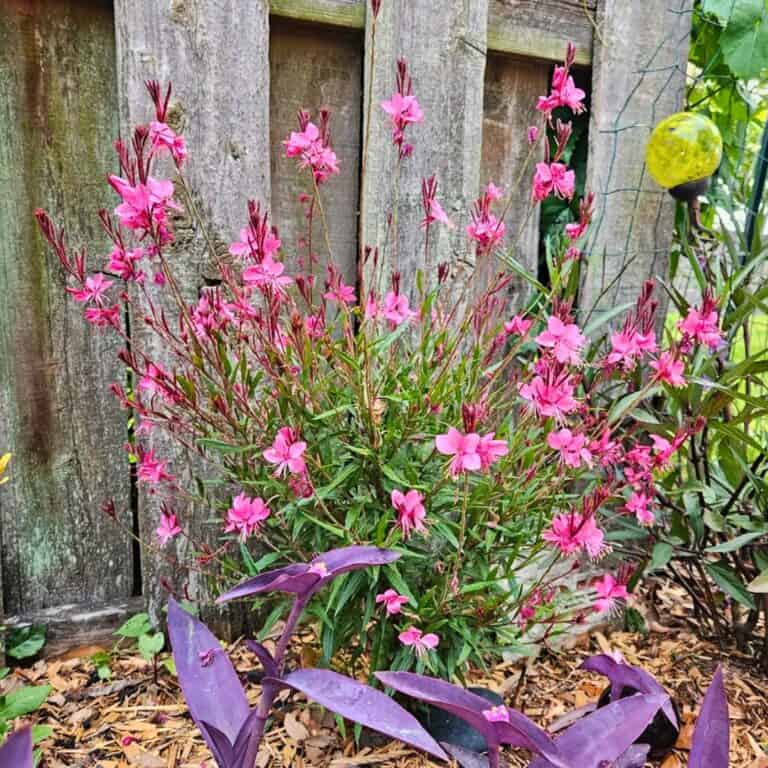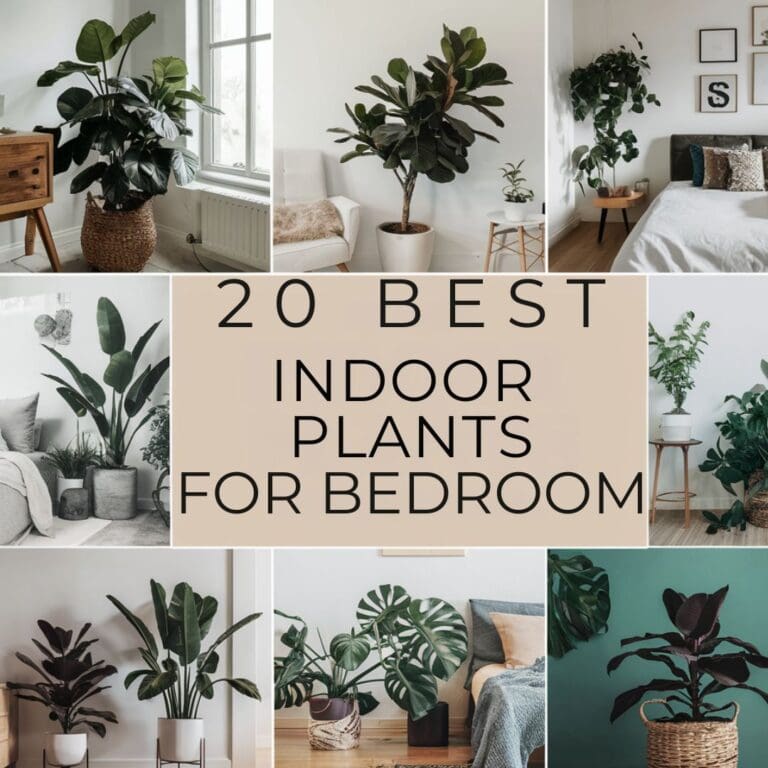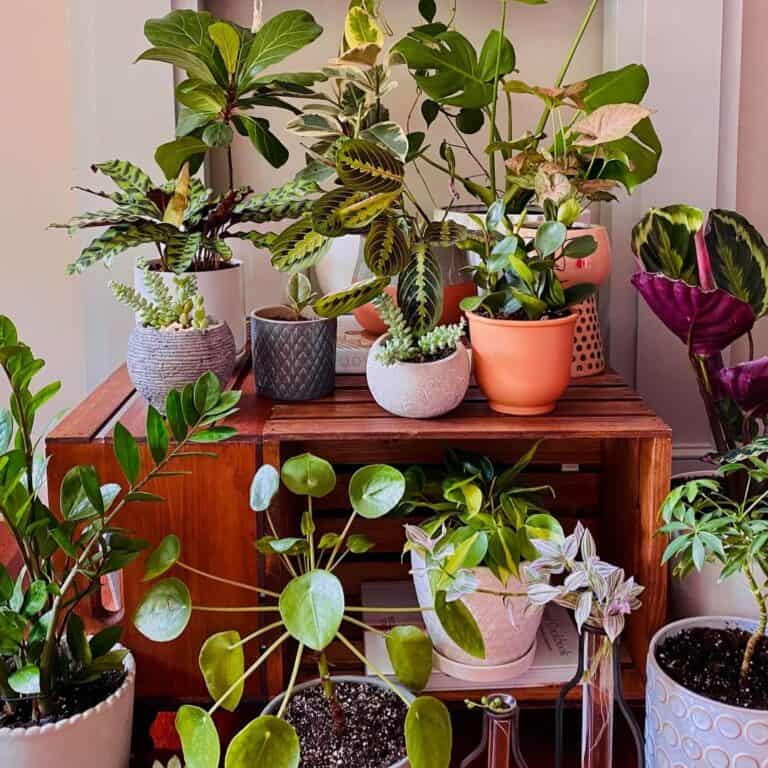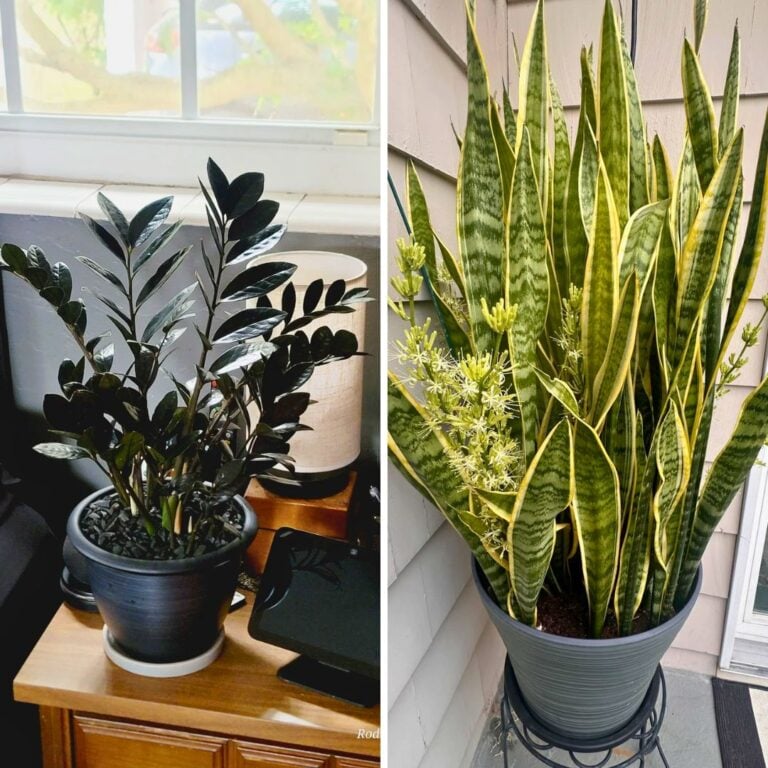19 Perfect Lavender Companion Plants You Must Grow
I can’t get enough of how lavender brings calm color and gentle fragrance to any garden.
Its soft purple blooms not only attract bees and butterflies, but they also fill the air with a relaxing scent that makes you want to linger outside.
Lavender really shines when it’s paired with plants that share its love for sun and dry soil.
Picking the right companion plants helps lavender stay healthy, bloom longer, and keeps pests at bay.
I’ve pulled together 19 fantastic options that thrive alongside lavender and make any garden look lively, balanced, and a little more magical.
Please note: Simplify Plants is reader-supported. As an Amazon Associate, I earn from qualifying purchases made by our readers with no extra cost added to you all! Some links in the post are affiliate links and I get a commission from purchases made through links in the post.
1) Rosemary

I always end up planting rosemary near my lavender. They both love full sun and well-drained soil, so I don’t have to fuss over their care.
Their shapes and textures just work together—rosemary’s upright stems next to lavender’s rounded mounds look tidy but never too formal.
I’ve found rosemary helps repel pests like mosquitoes and flies. That means my lavender stays healthier, and I don’t have to reach for sprays as often.
Both herbs are a magnet for pollinators like bees, and that’s always a win for blooms. Rosemary’s height adds a bit of structure to the bed, while lavender brings that soft, purple touch.
I use rosemary as a border or a backdrop, and the mix of green and purple is just so fresh. And when you brush past them or give them a little water, the scent is incredible.
Plus, I can snip rosemary for dinner without leaving the beauty of my lavender. I just make sure each plant gets enough space for air to move around.
That little bit of breathing room keeps mildew away and the soil from staying soggy. With a bit of care, these two herbs are a powerhouse duo in the garden.
2) Sage

I’m a big fan of sage next to lavender. They both thrive with full sun and well-drained soil, so I never have to stress about watering one more than the other.
Sage brings a lovely contrast in color and texture—its soft green leaves look striking beside lavender’s purple blossoms.
The combination makes the whole garden feel fuller and more harmonious. I’ve noticed that sage helps keep pests away, especially when it’s close to lavender.
Its scent seems to confuse bugs that might otherwise be a problem. That means less need for sprays or treatments, which I appreciate.
Sage, like lavender, also attracts pollinators—bees and butterflies can’t seem to decide which plant they love more. Watching them flit back and forth is one of my favorite summer sights.
Both sage and lavender are drought-tolerant, so I don’t have to water them much. I just make sure the soil drains well and avoid overwatering, since neither plant likes soggy roots.
I give sage a light trim now and then to keep it looking neat. The cuttings are great for cooking or crafts—it’s always nice to have something useful and pretty in the garden.
When I plant sage and lavender together, I leave about 12 to 18 inches between them. That way, they have room to grow and plenty of airflow.
Sage comes in so many varieties, from common garden sage to purple and tricolor types. Mixing a few kinds adds extra interest, and each one pairs beautifully with lavender’s color and scent.
Together, they create a low-maintenance, fragrant border that’s easy on the eyes (and the nose). They’re simple to care for, attract helpful insects, and just make the garden feel right.
3) Thyme

Thyme is one of my go-tos for planting beside lavender. Both love sun, dry weather, and well-drained soil, so they’re a breeze to grow together.
Thyme hugs the ground, so it won’t crowd out lavender or steal the spotlight. Its compact growth fills in gaps and keeps things looking tidy.
The little fragrant leaves of thyme draw in pollinators, just like lavender. When both are in bloom, the garden is alive with bees and a blend of scents.
I like that thyme acts as a natural mulch, helping to reduce weeds around my lavender. Less weeding? Yes, please.
Planting thyme along the edges adds texture and makes the garden feel lush without any extra work. There are loads of thyme types—creeping thyme and lemon thyme are two favorites.
I pick whichever fits the space and mood I’m after. Lavender and thyme together make a low-maintenance, drought-tolerant combo that smells amazing and looks balanced.
4) Catmint

Catmint just softens the whole look when you plant it near lavender. Its gray-green leaves and small purple-blue blooms blend with lavender’s color and shape, almost like they’re meant to be together.
Both plants love the same dry, well-drained soil, so I don’t worry about overwatering. When they’re side by side, they stay healthy and invite bees and butterflies all season.
Catmint is wonderfully low-maintenance. It doesn’t want rich soil or constant attention.
After it blooms, I snip it back a bit, and it bounces back with fresh flowers in no time. That keeps things tidy and colorful for months.
The scent of Catmint is gentle, but it actually helps deter some pests. I’ve seen fewer aphids and mosquitoes since adding it to the mix.
Lavender and Catmint both handle heat and drought once they’re settled in. They’re perfect for sunny borders, rock gardens, or containers—anywhere you want a relaxed, natural vibe.
Walking past them, the blend of lavender and Catmint fragrance is something special. It’s subtle, but it always makes me smile.
5) Echinacea

Echinacea (or coneflower) is a classic partner for lavender. Both love sunny spots and well-drained soil, so they’re easy to manage together.
Echinacea brings in pollinators—bees and butterflies can’t resist. When the two are planted together, the garden feels alive and bursting with color.
Their blooming times often overlap, so you get a long stretch of beautiful flowers through the summer.
Echinacea’s upright blooms look fantastic next to lavender’s softer, bushier shape. The contrast in color and form keeps things interesting without much effort.
Both plants handle heat and dry spells well, which means less watering for me. Echinacea is tough and comes back year after year, so I don’t have to replant.
Together, they make a balanced, low-maintenance garden bed that just gets better with time. If you’re after color, pollinators, and easy care, Echinacea is a no-brainer companion for lavender.
6) Yarrow
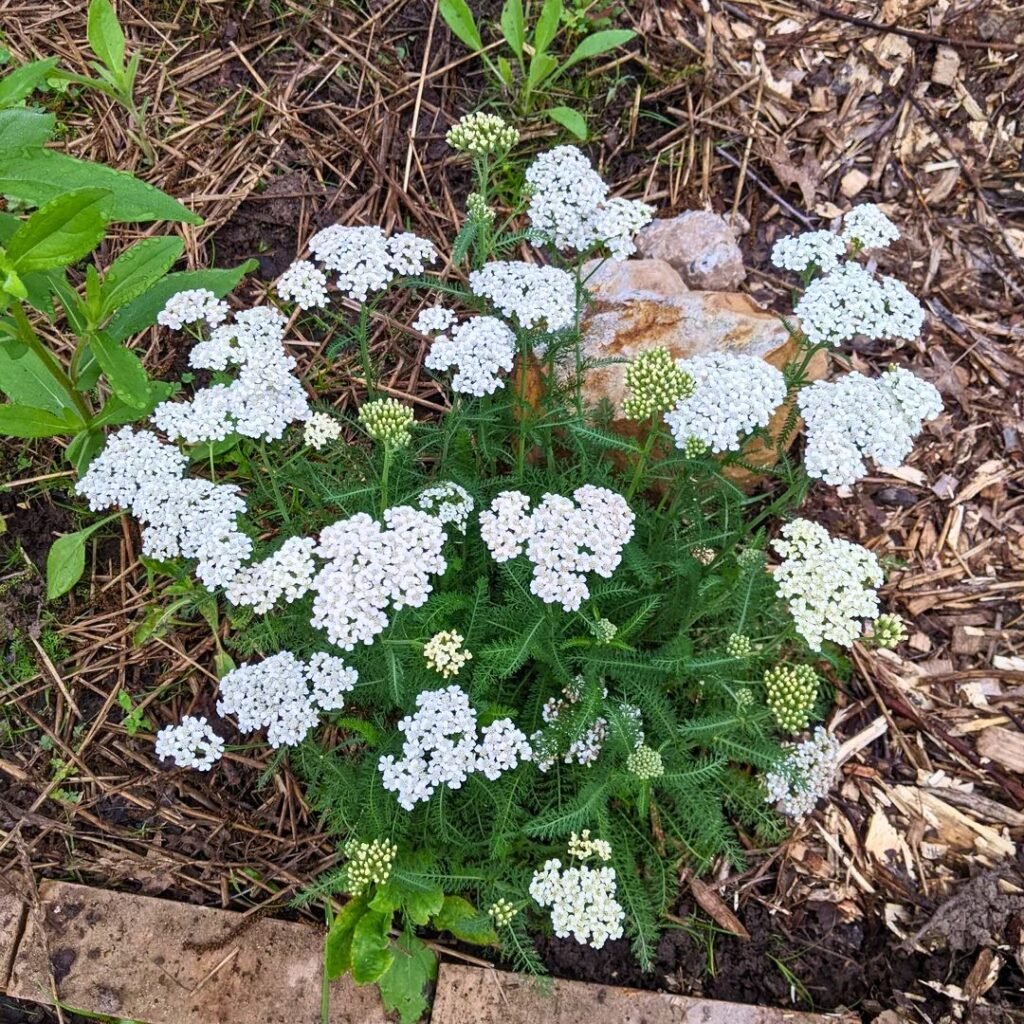
Yarrow is a favorite of mine to plant with lavender. They both like sunny, dry conditions and well-drained soil, so they’re happy together.
Yarrow’s feathery leaves and clusters of tiny flowers add texture next to lavender’s upright stems. The soft yellow, pink, or white blooms look lovely against lavender’s purple spikes.
This combo creates a calm, balanced look that I never get tired of. Yarrow attracts helpful insects—bees, butterflies, even ladybugs—which keeps the garden buzzing and healthy.
When Yarrow is blooming, I always notice more visitors to my lavender too. Yarrow is also tough as nails.
It handles heat, poor soil, and drought without a fuss. I never worry about it competing with lavender for water or nutrients.
After Yarrow flowers, I trim it back to keep things neat and encourage new growth. It bounces back fast, and regular deadheading helps it bloom longer.
Pairing lavender with Yarrow is a solid choice if you want a garden that’s pretty and good for pollinators. It’s hardy, simple, and brings just the right mix of color and texture.
7) Allium

Allium is one of those plants that just looks striking next to lavender. The tall, round flower heads stand out against lavender’s softer blooms, and both bring in bees and butterflies.
They both want full sun and well-drained soil, so they’re easy to care for as a pair. Once established, they don’t ask for much, which is always a plus in my book.
Allium’s strong scent actually helps keep pests away. Aphids, slugs, even deer tend to steer clear, so my lavender stays healthier too.
I usually plant Allium bulbs in the fall, and by late spring or early summer, those tall stems rise above the lavender. The mix of shapes and colors is simple but really catches the eye.
I’m careful to give both plants space for good air flow—helps prevent issues like mold, especially if it’s rainy. With a bit of sunlight and room, they both thrive.
If you want a garden that’s easy, beautiful, and full of life, pairing lavender with Allium is a smart move. They just work together, both in looks and in keeping the garden lively.
8) Sedum

I always recommend Sedum as a companion for lavender. Both love full sun, well-drained soil, and have low water needs, so maintenance is a breeze.
Sedum, or stonecrop, comes in all sorts of shapes and colors. Some types stay low, others get a bit taller, but all add interesting texture to a garden bed.
Their fleshy leaves store water, so they don’t mind a dry spell. Sedum’s late-summer blooms bring in bees and butterflies, keeping the garden lively even after the main lavender show is over.
The combination of soft lavender and Sedum’s bright clusters is always fresh. Sedum also puts up with poor soil and heat, so I don’t have to worry about babying it.
It fills in gaps, helps keep weeds down, and just makes everything look tidy with barely any effort. When planting Sedum near lavender, I make sure there’s enough space for air to move.
Both plants like things dry, so I skip the extra watering. If you want a low-maintenance partner for lavender, Sedum is a smart pick—contrast, color, pollinators, and ease all in one.
9) Salvia
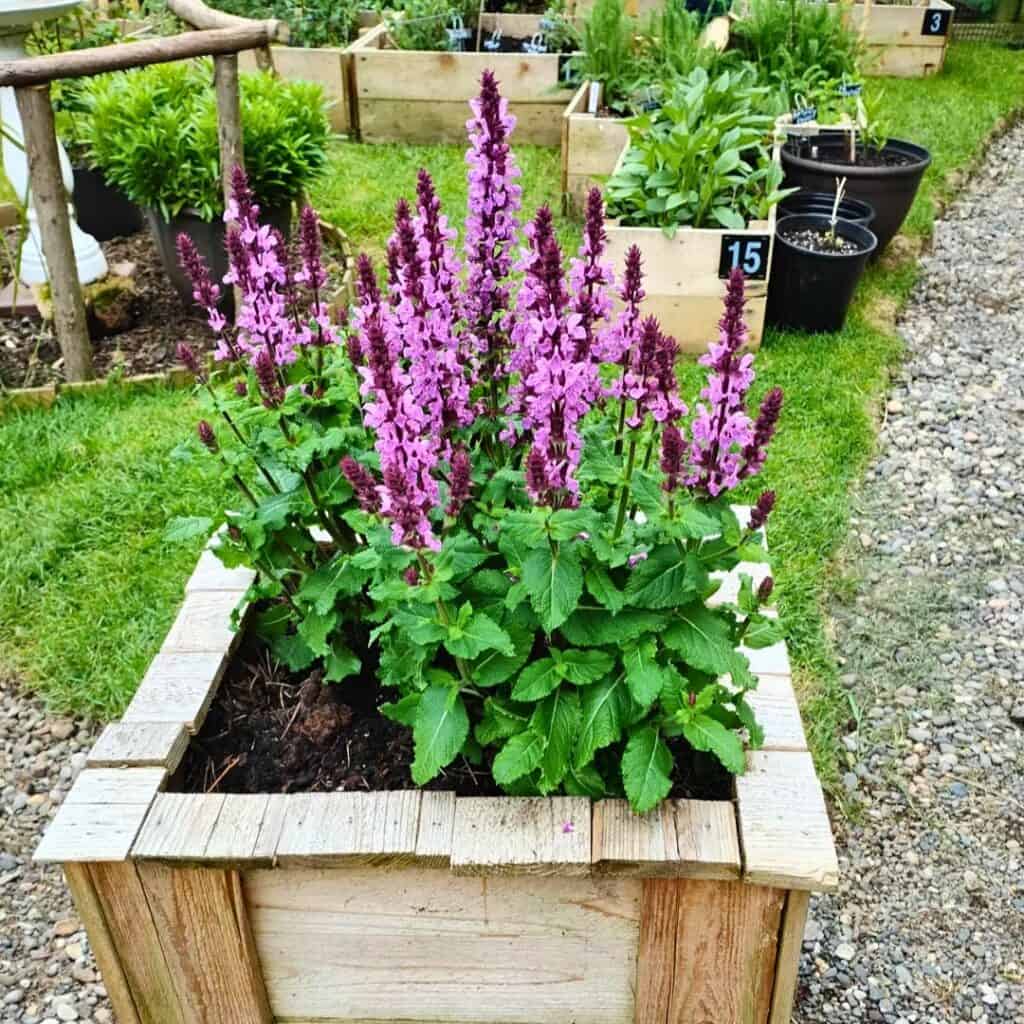
Honestly, I love growing Salvia near my lavender. Both plants just seem to crave the same sunny, dry spots, and they’re so easygoing once they settle in.
They don’t need much water, which is a relief if you don’t want to fuss over your garden every day. Perfect for anyone who likes things low-maintenance.
Salvia’s bright blooms really pop against lavender’s gentle purple. The red, pink, or blue flower spikes attract bees, butterflies, and even hummingbirds. I swear I see more pollinators buzzing around when I plant them together.
Both Salvia and lavender manage heat like champs. I just make sure they get enough sunlight and space to stretch out. Good air flow is key—it helps keep mildew at bay and just seems to keep everything healthier.
Salvia’s strong scent and oils can actually deter pests that might bother lavender. I appreciate having a natural companion that helps keep my garden chemical-free.
When I plant Salvia, I leave a bit of space between it and the lavender. It gives both plants room for their roots, and they don’t end up crowding each other. A thin layer of mulch helps keep the soil cool and cuts down on weeds.
If you want a longer bloom season, try mixing up different Salvia varieties. Some flower earlier, some later, so you get color from spring through fall. Deadheading old flowers keeps new ones coming, though I sometimes forget and it still looks pretty good.
Salvia and lavender together just make my garden feel vibrant and balanced. The mix of colors and textures is interesting, but it never feels like too much work. Honestly, it’s one of my favorite combos for a sunny border or a big patio pot.
10) Lavatera

I can’t help but love growing Lavatera—tree mallow, if you prefer—near my lavender. The soft green leaves and those big pink or white blooms really pop next to the purple. The combo just makes the whole garden feel cheerful.
Lavatera grows fast and fills in empty spots before you know it. It creates a gentle backdrop for lavender, which makes the purple look even richer. Both plants like full sun and well-drained soil, so I don’t have to do anything special to keep them happy together.
Bees and butterflies seem to love Lavatera, and I notice a lot more activity in my garden when it’s blooming. It keeps things lively and helps out the local pollinators.
I usually give Lavatera a light trim after it flowers. It responds really well to pruning and sometimes surprises me with another round of blooms later in the season.
Lavatera handles dry spells with ease, so it’s a perfect match for lavender’s low-water style. I water them both sparingly once they’ve settled in. Too much water can be a problem, so well-drained soil is a must.
When I plant Lavatera near lavender, I make sure there’s enough space for air to move between them. This helps prevent mildew and lets each plant show off a bit.
I like putting Lavatera along borders or fences. The tall stems add height, while lavender fills in below for a layered, natural look.
Lavatera’s easy to grow from seed, so I can start new plants every year if I want. Sometimes I mix up the colors just to keep things interesting.
Lavatera and lavender want the same things: sunlight, warmth, and dry soil. I barely have to change my routine, and they both thrive.
Adding Lavatera near my lavender gives the garden a soft, colorful look with almost no effort. It’s one of those pairings that just works—simple, tough, and full of charm.
11) Gaura

There’s something special about Gaura—it brings a light, airy vibe that I really enjoy. The tall, slender stems and delicate white or pink flowers sway in the breeze, and they look great next to lavender’s tidy, compact shape.
Both plants are fans of full sun and well-drained soil, so they’re easy to grow together. Gaura’s drought tolerance makes it an obvious partner for lavender, especially if your garden gets pretty dry.
Gaura blooms from late spring all the way through fall. This is handy because it fills in color when lavender isn’t at its peak.
It’s also wonderfully low-maintenance. Gaura doesn’t need much water, doesn’t care about rich soil, and shrugs off the heat. I usually give it a quick trim after the first flush of flowers, and that’s about it.
When I plant Gaura near lavender, I keep about a foot of space between them. That way, each plant has room to breathe, but they still create a balanced, natural look. The mix of lavender’s purple and Gaura’s soft blooms just feels calm.
Bees and butterflies love both plants, so there’s always something buzzing around. It adds life and movement, which I never get tired of watching.
Gaura’s fine texture is a nice contrast to lavender’s denser foliage. The difference in shape and form makes things more interesting, but nothing feels crowded.
If you’re after a relaxed, cottage-style garden, Gaura and lavender pair up nicely with other sun-lovers like salvia or yarrow. It’s easy to mix and match since their care is so similar.
I’ve noticed Gaura stands up to wind better than a lot of other flowers. Its flexible stems make it a reliable pick for breezy spots.
For me, Gaura is one of the easiest ways to add movement, color, and a bit of charm around lavender. It’s graceful, tough, and fits right in with a sunny, low-water garden.
12) Coreopsis
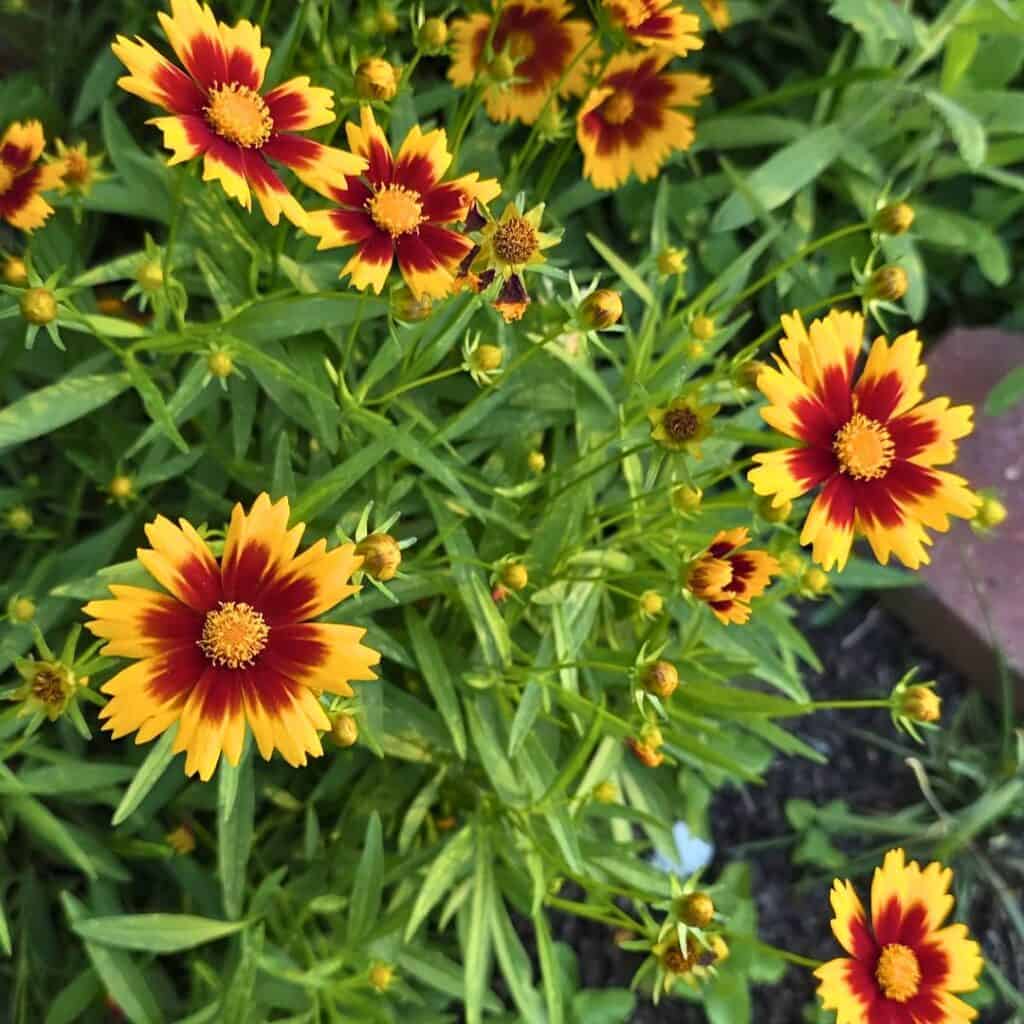
I really enjoy growing Coreopsis next to my lavender. Both plants love sunny, dry spots and well-drained soil, so they’re a breeze to care for together.
The bright yellow blooms of Coreopsis look fantastic against lavender’s soft purple. The color combo is cheerful without being overwhelming. Plus, bees and butterflies seem to flock to them, which is always a good thing.
Coreopsis puts on a long show, blooming from early summer into fall. I trim off the spent blooms to keep new ones coming, and it lines up nicely with the light pruning I do for lavender.
Both plants handle heat well and don’t ask for much from the soil. As long as they get plenty of sun and some space for air to flow, they stay happy.
I like mixing different Coreopsis varieties with lavender for more texture. The fine leaves of lavender and the daisy-like Coreopsis petals make the bed look balanced and natural.
Coreopsis is great for filling in gaps around lavender. Its bushy growth covers bare soil, which means fewer weeds and more moisture staying put. Less work for me, honestly.
If you want a low-maintenance, bright garden, Coreopsis is a top pick. It’s tough, easy to grow, and pairs beautifully with lavender’s mellow tones.
13) Shasta Daisy

There’s something about Shasta Daisies that just lifts the mood. The crisp white petals and sunny yellow centers brighten up the garden, especially next to the soft purple of lavender. Both love full sun and well-drained soil, so growing them together is a no-brainer.
When I plant them side by side, I notice how their colors play off each other. The upright daisies and rounded lavender form a tidy, balanced look that’s easy on the eyes.
Shasta Daisies attract pollinators like crazy—bees and butterflies can’t resist them, just like with lavender. It keeps the garden lively and full of movement, which I love.
Daisies don’t need much fussing over. Once they’re settled, they’re just as low-maintenance as lavender. I keep an eye on the soil and try not to overwater.
Deadheading the daisies keeps them blooming and looking fresh. Lavender gets a trim too, so I usually do both at once and call it a day.
I like planting Shasta Daisies in clusters behind or beside lavender. The white flowers really make the purple pop, even from across the yard. It’s an easy way to add contrast without extra work.
Both plants want the same things—lots of sun, not too much water, and good air flow. They rarely compete, so everything just grows better together.
Whenever I’m planning a new spot in the garden, I always tuck in a few Shasta Daisies near my lavender. The combo makes the space more inviting and gives it that classic, clean look all summer.
14) Russian Sage
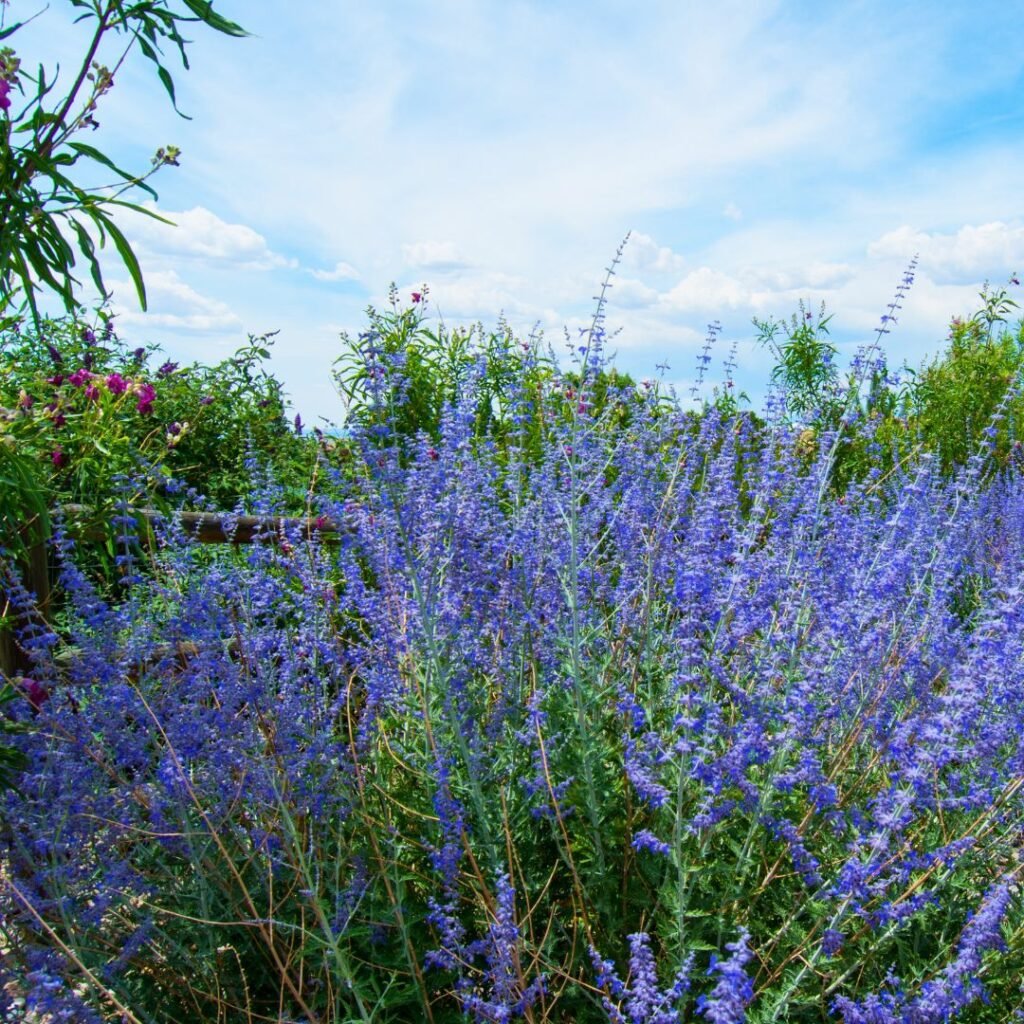
There’s just something about Russian Sage and lavender together—they look amazing and pretty much want the same care. Both crave full sun and well-drained soil, so I never worry about one outgrowing the other.
Russian Sage brings in silvery-green leaves and tall spikes of purple-blue flowers that last for ages. The colors blend so well with lavender, it’s almost too easy.
Bees and butterflies are all over Russian Sage, and it helps pollinate everything else nearby. Plus, it seems to keep pests away, which is a nice bonus.
It’s drought-tolerant, so I barely have to water it. Even in the hottest weather, it just keeps going—just like lavender.
I usually plant Russian Sage a few feet from my lavender. They fill in space nicely but don’t crowd each other, which keeps the garden looking full and balanced.
When I trim my lavender, I also cut back Russian Sage in late winter or early spring. It keeps everything tidy and encourages fresh growth.
Honestly, the best part is how little maintenance Russian Sage needs. Once it’s settled, I can almost forget about it and it still looks great year after year.
If you’re after a low-care garden with soft colors and a laid-back feel, lavender and Russian Sage are a winning pair.
15) Bee Balm

Bee Balm is just fun to grow near lavender. The bright red, pink, or purple flowers attract bees, butterflies, and hummingbirds all summer, so the garden’s always buzzing with life.
Bee Balm likes full sun and well-drained soil—same as lavender. I give it enough space since it can spread pretty fast, and a little trimming keeps everything neat.
It’s great for improving pollination around the garden. Bees bounce from Bee Balm to lavender, and I usually see more blooms and better growth all around.
I love the contrast—Bee Balm’s tall, bold colors next to lavender’s soft purple. It makes for a balanced, eye-catching display that looks good without a ton of effort.
Bee Balm is easy to care for. I water it during dry spells and deadhead the old flowers, but that’s about it. It’s tough, comes back every year, and always earns its spot by the lavender.
If you want more pollinators and a burst of color near your lavender, Bee Balm is a top choice. It’s low-maintenance, productive, and honestly, just makes the garden better.
16) Foxglove

I love growing Foxglove near my lavender. It just adds such a nice pop of height and color to the garden. Those tall flower spikes really stand out against the soft lavender mounds, and the mix of purple, pink, and white blooms always feels lively but never overwhelming.
Foxglove prefers partial shade, which actually works well with lavender’s need for full sun. I usually plant them where both get enough light but aren’t baking all day. Somehow, this keeps both plants happy and looking great throughout the season.
These flowers are also a magnet for bees and hummingbirds. I see more pollinators buzzing around when I have both in the same spot. It’s a simple way to help local wildlife and enjoy a more colorful garden.
Foxglove likes well-drained soil—same as lavender. I’m always careful that the soil doesn’t get soggy after rain. Good drainage keeps their roots healthy and helps avoid rot, which neither plant tolerates well.
One thing I always keep in mind: Foxglove is toxic if eaten. So, I make sure it’s out of reach from pets and little kids. Still, it’s such a charming plant for adding structure to a flower bed, and those tall blooms make lavender’s low shape pop even more.
When I group them together, the balance is obvious. The soft scent of lavender mixed with Foxglove’s bold look turns a corner of my garden into a calm, eye-catching space. Honestly, it’s one of my favorite combinations for a relaxed, natural vibe.
17) Marigold

I can’t resist planting marigolds near my lavender—they just make everything look so much brighter and happier. Those orange and yellow blooms really pop against the soft purple of the lavender. The color combo always draws the eye and gives my garden beds a warm, balanced feel.
Marigolds are also great for protecting lavender from pests. They naturally repel aphids, whiteflies, and nematodes, which can be a real pain. Since I started growing them together, I’ve had way fewer pest problems. Marigolds just make sense as companions.
Both plants enjoy full sun and well-drained soil, so they’re easy to care for side by side. I don’t have to stress about watering, since marigolds handle dry spells almost as well as lavender. It makes the whole process pretty low-stress.
Marigolds bloom for ages, too. Their bright flowers stick around most of the season, keeping things colorful even when other plants start to fade. They also bring in pollinators like bees and butterflies, which helps my lavender bloom more.
When I plant marigolds, I give each one a few inches of space. They fill in gaps nicely and make a tidy border around my lavender patch. The end result is a neat, cheerful garden that’s easy to keep up and nice to look at.
Adding marigolds to my lavender garden gives me both beauty and function. They add color, attract helpful bugs, and keep pests at bay—all without much fuss. For me, it’s one of the simplest ways to keep my garden healthy and vibrant all season.
18) Basil
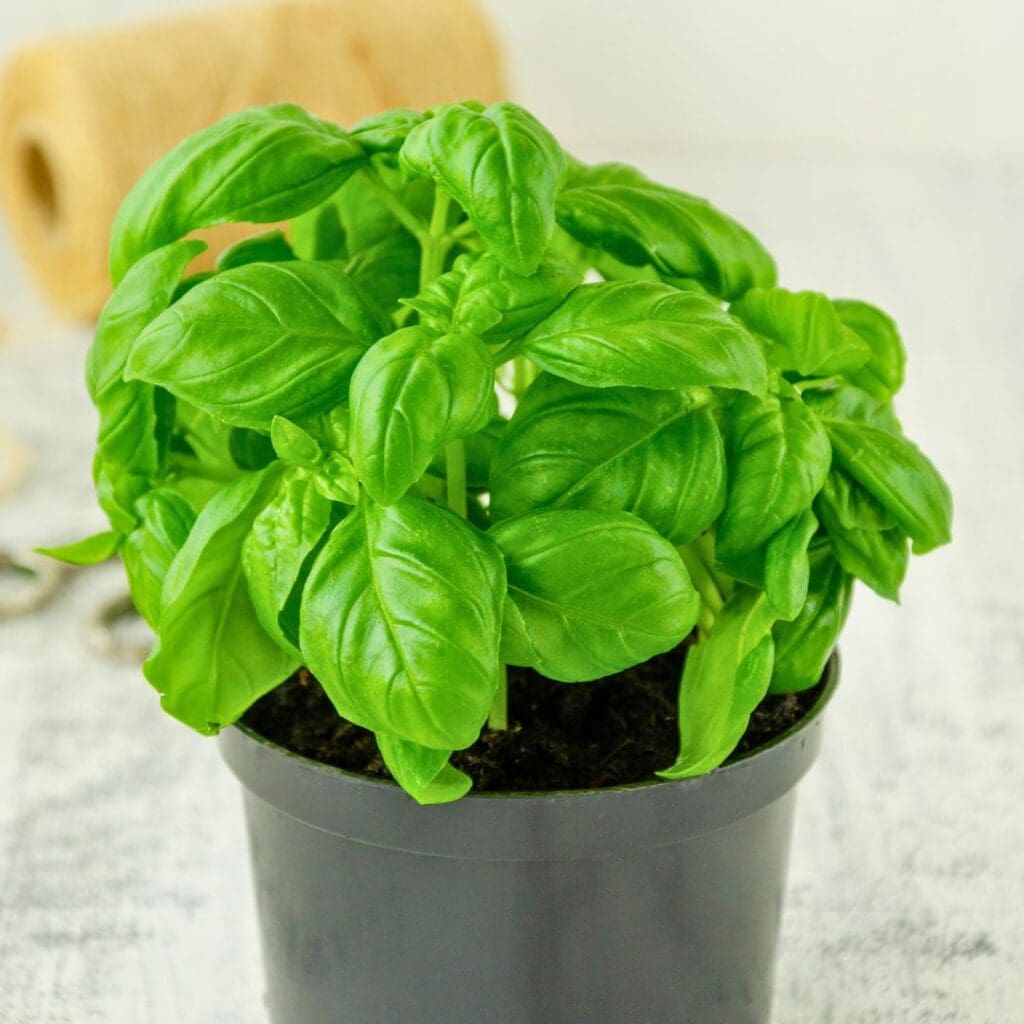
I love putting basil next to my lavender. Both plants like plenty of sunlight and well-drained soil, so they get along well in a sunny bed.
Basil’s strong scent is great for keeping away pests like mosquitoes and aphids. It’s kind of a natural shield, which means I don’t have to use as many sprays to keep my lavender healthy.
Both plants prefer moderate watering. I just let the soil dry a bit between waterings and don’t stress about it too much.
Basil really thrives when I harvest it often. Snipping off leaves encourages more growth and keeps the plant bushy. Plus, it’s always nice to have fresh basil for cooking.
Growing basil and lavender together means my garden looks good and smells amazing. The combo of sweet and herbal scents creates a relaxing spot I love to hang out in.
19) Fennel

I like growing fennel near my lavender. Both plants love full sun and well-drained soil, so it makes planning the garden easier.
Fennel’s tall, feathery leaves add some nice texture and height next to lavender’s compact shape. The contrast is actually pretty striking and helps the garden look balanced.
Fennel attracts beneficial insects like ladybugs and hoverflies, which help control pests that might bother lavender. It’s a natural way to keep things healthy.
I do keep a little space between fennel and lavender. Fennel can release compounds that affect other plants, so I avoid planting them too close. That small gap seems to help both do well.
I also use fennel in my cooking. The bulbs and seeds are great in salads, soups, and teas, and having it near the lavender patch makes harvesting easy.
Fennel’s yellow flower clusters bloom in summer and attract pollinators. I often see bees moving from fennel to lavender, which helps both plants produce better.
When I water, I’m careful not to overdo it. Both plants prefer it on the dry side, so I let the soil dry out between waterings.
Fennel and lavender together just make a visually appealing and functional garden spot. They support pollinators, keep pests down, and the scents are lovely.
Pairing them gives my garden a calm, organized look. It’s a good choice if you like low-maintenance plants that do double duty.
Benefits of Companion Planting With Lavender
Planting lavender near other crops just makes sense. It helps keep pests away, brings in helpful bugs, and adds a lot of beauty to the garden. The scent, color, and growth habits make lavender a surprisingly useful and attractive companion for many plants.
Pest Control Advantages
I love how lavender’s strong scent naturally repels pests like moths, flies, mosquitoes, and fleas. When I plant it near veggies or herbs, it acts as a barrier—no chemicals needed.
Lavender’s essential oils confuse pests by masking the scent of nearby plants. That’s a big help for crops like cabbage, lettuce, and carrots, which can get hit hard by common garden invaders.
I’ve definitely seen ants and aphids avoid areas close to lavender. That means fewer infestations and healthier plants for me.
Here’s a quick summary of how lavender helps with pest control:
| Pest Type | Effect of Lavender | Example Plants Protected |
|---|---|---|
| Aphids | Repelled by scent | Roses, beans |
| Moths | Avoid lavender aroma | Cabbage, kale |
| Mosquitoes | Stay away from oils | Outdoor seating areas |
Attracting Pollinators
Lavender’s fragrant blooms draw in bees, butterflies, and other pollinators that help nearby plants produce more fruit and seeds. I’ve seen a single patch of lavender boost pollination in my veggie beds.
The flowers stay open for ages, giving pollinators a steady food source. That keeps them coming back and helps keep the garden balanced.
I also like that lavender blooms at the same time as many herbs and vegetables, like thyme and tomatoes. The overlap draws pollinators to a bunch of plants at once, which naturally improves yields.
Enhancing Garden Aesthetics
Lavender adds so much color, texture, and fragrance to my garden. The purple flowers and silvery-green leaves make a nice contrast with all the green foliage and brighter blooms.
I love planting lavender along borders or pathways. It gives the garden a clean, organized look but still feels relaxed and natural. The scent just makes being outside more enjoyable.
Lavender pairs well with plants like roses, echinacea, and sage. The garden feels cohesive and inviting, and the evergreen leaves keep things interesting even after the flowers fade.
Tips for Growing Lavender With Other Plants
I keep my lavender happy by making sure it has the right soil, proper watering, and enough space and sun. These details really help it thrive, especially alongside other plants with similar needs.
Soil and Watering Requirements
I always go for well-draining soil since lavender hates sitting in water. Sandy or loamy soil works best. If mine’s too heavy, I mix in some coarse sand or small gravel to loosen it up.
Lavender likes slightly alkaline soil with a pH between 6.5 and 7.5. I try to check the soil once a year to keep it in that range. When I water, I let the top inch dry out first.
Overwatering is a no-go—it can cause root rot. I water deeply but not too often, especially in hot weather. When I grow lavender with other herbs like rosemary or sage, I keep them together since they all like it dry.
| Soil Type | Ideal Condition | Notes |
|---|---|---|
| Sandy/Loamy | Drains quickly | Best for lavender |
| Clay | Holds water | Mix with sand or gravel |
| pH 6.5–7.5 | Slightly alkaline | Check yearly |
Spacing and Sunlight Considerations
Lavender needs full sun, at least 6 to 8 hours a day. I plant it where it won’t get shaded by taller plants. Not enough sun, and it just won’t bloom as much.
I keep 12 to 18 inches between plants for good airflow. That helps prevent mildew and keeps the leaves dry. For companions, I pick low-growing, sun-loving plants like thyme or oregano that won’t crowd the lavender.
If I’m growing in containers, I make sure each pot gets direct sun and has space for roots to spread. Getting the spacing and sunlight right keeps my lavender strong and fragrant all season.
Frequently Asked Questions
I usually pair lavender with plants that love sunny, dry spots too. These companions share similar water and soil needs, so they help each other stay healthy and look great together.
What are some great companion plants for lavender in the garden?
I really like planting rosemary, sage, and thyme next to my lavender. They all love soaking up the sun and don’t fuss over dry soil, so it’s pretty easy to keep the whole bed happy—and honestly, the mix of scents is fantastic.
How do I choose plants that will thrive alongside my lavender?
I usually stick with plants that want lots of sunlight and don’t mind dry feet. Lavender just can’t stand soggy roots, so anything that needs constant watering is out for me.
Can you suggest any herbs that grow well with lavender?
Thyme, sage, and rosemary are my go-tos. They all seem to get along well, and I’ve noticed bees and other pollinators love them too.
Are there any flowers that complement lavender’s growth and care needs?
I’ve had good luck with catmint and echinacea. Both can handle dry conditions and, honestly, they look so good next to the lavender’s purple blooms.
What types of shrubs or perennials make good neighbors for lavender?
I like adding small ornamental grasses or sedum around my lavender. They don’t mind the heat or a dry spell, and they keep the space looking pretty neat without much effort.
Which companion plants can help improve the health and aroma of my lavender?
Herbs like rosemary and thyme are great neighbors for lavender. They help with air circulation and can even cut down on pests.
Plus, their bold scents seem to bring out the best in the lavender’s fragrance. Isn’t it nice when plants just get along?
Recommended Garden Supplies
| Product Image | Our Recommended Gardening Supplies | Check Offers! |
|---|---|---|
Top Top
Top
Top
Top
Top
Top
Top
Top | rePotme Houseplant and Tropical Classic Potting Soil Mix | Check Offer On Amazon |
 Top
Top
Top
Top
Top
Top
Top
Top | Espoma Organic Indoor Plant Food | Check Offer On Amazon |
 Top
Top
Top
Top
Top
Top
Top
Top | GooingTop LED Grow Light 6000K Full Spectrum Clip Plant Growing Lamp | Check Offer On Amazon |
 Top
Top
Top
Top
Top
Top
Top
Top | Soil Moisture Meter | Check Offer On Amazon |
 Top
Top
Top
Top
Top
Top
Top
Top | Govee Hygrometer Thermometer, Bluetooth Enabled! | Check Offer On Amazon |
 Top
Top | LEVOIT Humidifiers for Large Room(Best For Plants) | Check Offer On Amazon |
 Top
Top
Top
Top
Top
Top
Top
Top | Upgraded DIY Automatic Drip Irrigation Kit, 15 Potted Houseplants Support | Check Offer On Amazon |
 Top
Top
Top
Top
Top
Top
Top
Top | Stainless Steel Heavy Duty Gardening Tool Set | Check Offer On Amazon |
 Top
Top
Top
Top
Top
Top
Top
Top | Bonide Insecticidal Soap | Check Offer On Amazon |
 Top
Top
Top
Top
Top
Top
Top
Top | Bonide 32 oz Spray Neem Oil for Organic Gardening | Check Offer On Amazon |
 Top
Top
Top
Top
Top
Top
Top
Top | Garden Safe Fungicide | Check Offer On Amazon |
Note: Some images in the articles are sourced from Reddit and Other Platforms For Reference Purpose.

